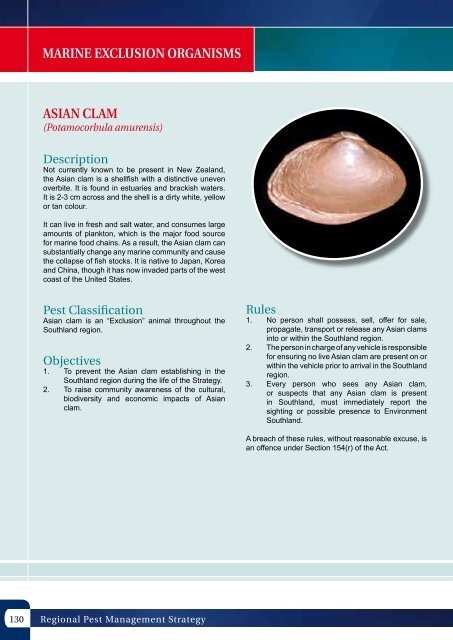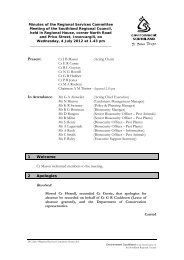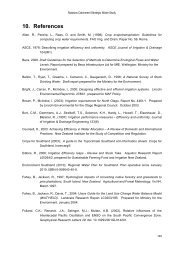You also want an ePaper? Increase the reach of your titles
YUMPU automatically turns print PDFs into web optimized ePapers that Google loves.
130<br />
MaRinE ExcluSion oRganiSMS<br />
aSian claM<br />
(Potamocorbula amurensis)<br />
Description<br />
Not currently known to be present in New Zealand,<br />
the Asian clam is a shellfish with a distinctive uneven<br />
overbite. It is found in estuaries and brackish waters.<br />
It is 2-3 cm across and the shell is a dirty white, yellow<br />
or tan colour.<br />
It can live in fresh and salt water, and consumes large<br />
amounts of plankton, which is the major food source<br />
for marine food chains. As a result, the Asian clam can<br />
substantially change any marine community and cause<br />
the collapse of fish stocks. It is native to Japan, Korea<br />
and China, though it has now invaded parts of the west<br />
coast of the United States.<br />
Pest Classification<br />
Asian clam is an “Exclusion” animal throughout the<br />
<strong>Southland</strong> region.<br />
Objectives<br />
1. To prevent the Asian clam establishing in the<br />
<strong>Southland</strong> region during the life of the Strategy.<br />
2. To raise community awareness of the cultural,<br />
biodiversity and economic impacts of Asian<br />
clam.<br />
Regional Pest Management Strategy<br />
Rules<br />
1. No person shall possess, sell, offer for sale,<br />
propagate, transport or release any Asian clams<br />
into or within the <strong>Southland</strong> region.<br />
2. The person in charge of any vehicle is responsible<br />
for ensuring no live Asian clam are present on or<br />
within the vehicle prior to arrival in the <strong>Southland</strong><br />
region.<br />
3. Every person who sees any Asian clam,<br />
or suspects that any Asian clam is present<br />
in <strong>Southland</strong>, must immediately report the<br />
sighting or possible presence to <strong>Environment</strong><br />
<strong>Southland</strong>.<br />
A breach of these rules, without reasonable excuse, is<br />
an offence under Section 154(r) of the Act.





